Analyzing Leadership Theories, Power Dynamics: Tutorial 4 Assignment
VerifiedAdded on 2021/10/01
|9
|1998
|74
Homework Assignment
AI Summary
This assignment delves into the multifaceted realm of leadership, commencing with fundamental definitions and exploring various theories. It examines trait theory, highlighting the characteristics of effective leaders, and contrasts different leadership styles, including autocratic, democratic, and laissez-faire approaches. The assignment then transitions to contingency theories, such as Fiedler's model and the path-goal model, analyzing how leadership effectiveness hinges on situational factors. Further, it investigates the leader-member exchange (LMX) theory, transactional and transformational leadership, and charismatic leadership. Finally, it dissects the concepts of power, authority, and influence, differentiating between position and personal power, along with various power bases like reward, coercive, legitimate, expert, rational persuasion, and referent power. The document provides a comprehensive overview of leadership principles and their practical applications.
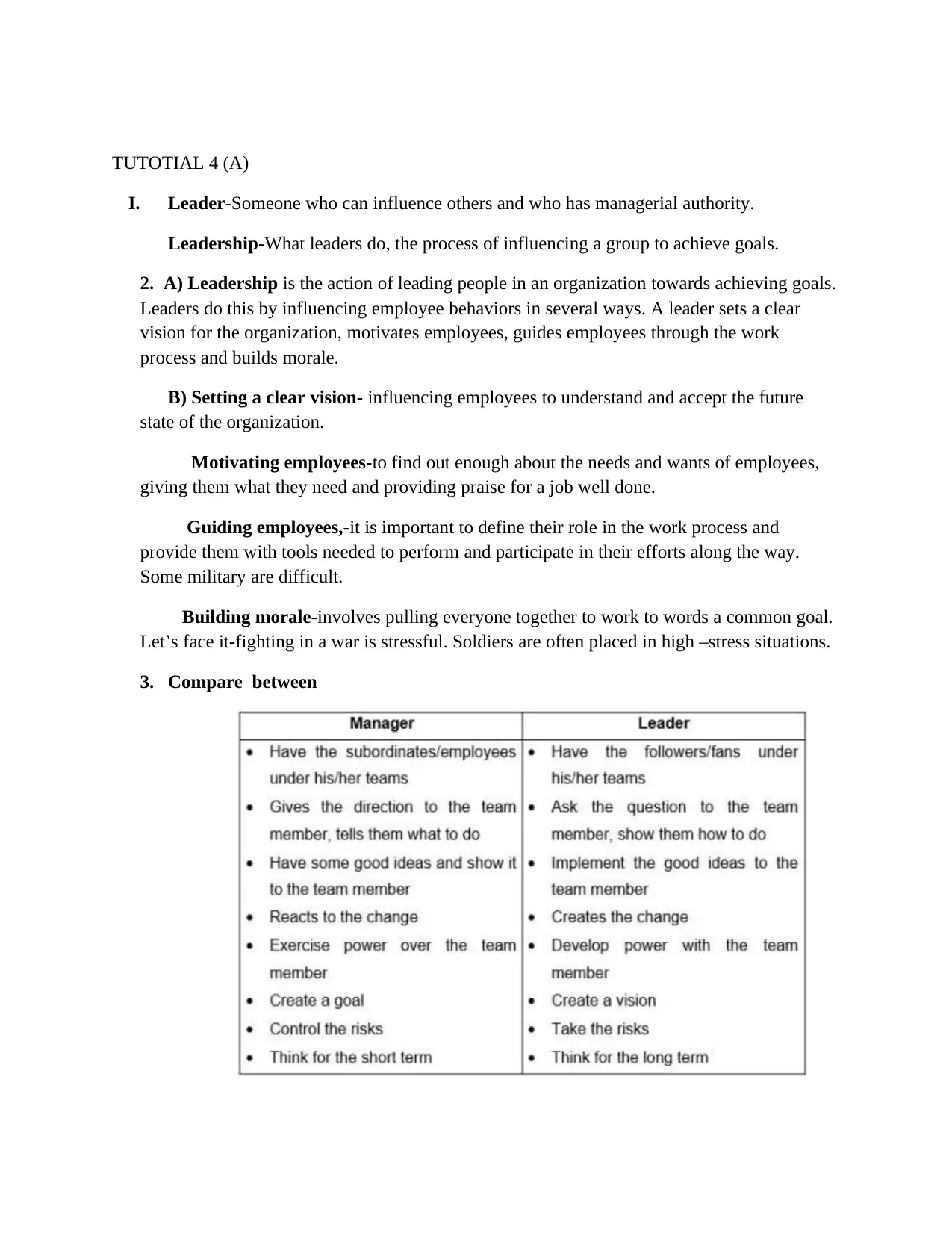
TUTOTIAL 4 (A)
I. Leader-Someone who can influence others and who has managerial authority.
Leadership-What leaders do, the process of influencing a group to achieve goals.
2. A) Leadership is the action of leading people in an organization towards achieving goals.
Leaders do this by influencing employee behaviors in several ways. A leader sets a clear
vision for the organization, motivates employees, guides employees through the work
process and builds morale.
B) Setting a clear vision- influencing employees to understand and accept the future
state of the organization.
Motivating employees-to find out enough about the needs and wants of employees,
giving them what they need and providing praise for a job well done.
Guiding employees,-it is important to define their role in the work process and
provide them with tools needed to perform and participate in their efforts along the way.
Some military are difficult.
Building morale-involves pulling everyone together to work to words a common goal.
Let’s face it-fighting in a war is stressful. Soldiers are often placed in high –stress situations.
3. Compare between
I. Leader-Someone who can influence others and who has managerial authority.
Leadership-What leaders do, the process of influencing a group to achieve goals.
2. A) Leadership is the action of leading people in an organization towards achieving goals.
Leaders do this by influencing employee behaviors in several ways. A leader sets a clear
vision for the organization, motivates employees, guides employees through the work
process and builds morale.
B) Setting a clear vision- influencing employees to understand and accept the future
state of the organization.
Motivating employees-to find out enough about the needs and wants of employees,
giving them what they need and providing praise for a job well done.
Guiding employees,-it is important to define their role in the work process and
provide them with tools needed to perform and participate in their efforts along the way.
Some military are difficult.
Building morale-involves pulling everyone together to work to words a common goal.
Let’s face it-fighting in a war is stressful. Soldiers are often placed in high –stress situations.
3. Compare between
Paraphrase This Document
Need a fresh take? Get an instant paraphrase of this document with our AI Paraphraser
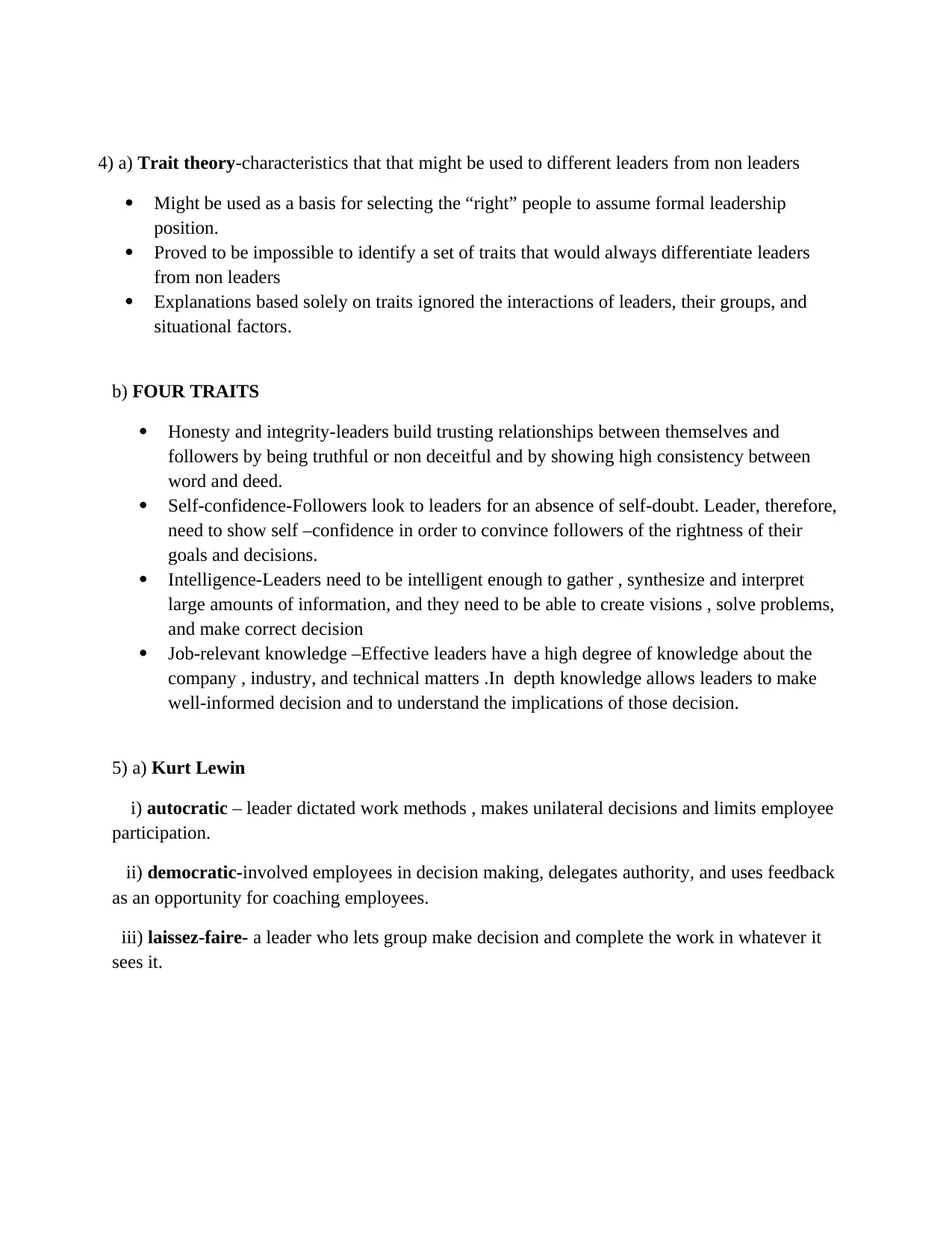
4) a) Trait theory-characteristics that that might be used to different leaders from non leaders
Might be used as a basis for selecting the “right” people to assume formal leadership
position.
Proved to be impossible to identify a set of traits that would always differentiate leaders
from non leaders
Explanations based solely on traits ignored the interactions of leaders, their groups, and
situational factors.
b) FOUR TRAITS
Honesty and integrity-leaders build trusting relationships between themselves and
followers by being truthful or non deceitful and by showing high consistency between
word and deed.
Self-confidence-Followers look to leaders for an absence of self-doubt. Leader, therefore,
need to show self –confidence in order to convince followers of the rightness of their
goals and decisions.
Intelligence-Leaders need to be intelligent enough to gather , synthesize and interpret
large amounts of information, and they need to be able to create visions , solve problems,
and make correct decision
Job-relevant knowledge –Effective leaders have a high degree of knowledge about the
company , industry, and technical matters .In depth knowledge allows leaders to make
well-informed decision and to understand the implications of those decision.
5) a) Kurt Lewin
i) autocratic – leader dictated work methods , makes unilateral decisions and limits employee
participation.
ii) democratic-involved employees in decision making, delegates authority, and uses feedback
as an opportunity for coaching employees.
iii) laissez-faire- a leader who lets group make decision and complete the work in whatever it
sees it.
Might be used as a basis for selecting the “right” people to assume formal leadership
position.
Proved to be impossible to identify a set of traits that would always differentiate leaders
from non leaders
Explanations based solely on traits ignored the interactions of leaders, their groups, and
situational factors.
b) FOUR TRAITS
Honesty and integrity-leaders build trusting relationships between themselves and
followers by being truthful or non deceitful and by showing high consistency between
word and deed.
Self-confidence-Followers look to leaders for an absence of self-doubt. Leader, therefore,
need to show self –confidence in order to convince followers of the rightness of their
goals and decisions.
Intelligence-Leaders need to be intelligent enough to gather , synthesize and interpret
large amounts of information, and they need to be able to create visions , solve problems,
and make correct decision
Job-relevant knowledge –Effective leaders have a high degree of knowledge about the
company , industry, and technical matters .In depth knowledge allows leaders to make
well-informed decision and to understand the implications of those decision.
5) a) Kurt Lewin
i) autocratic – leader dictated work methods , makes unilateral decisions and limits employee
participation.
ii) democratic-involved employees in decision making, delegates authority, and uses feedback
as an opportunity for coaching employees.
iii) laissez-faire- a leader who lets group make decision and complete the work in whatever it
sees it.
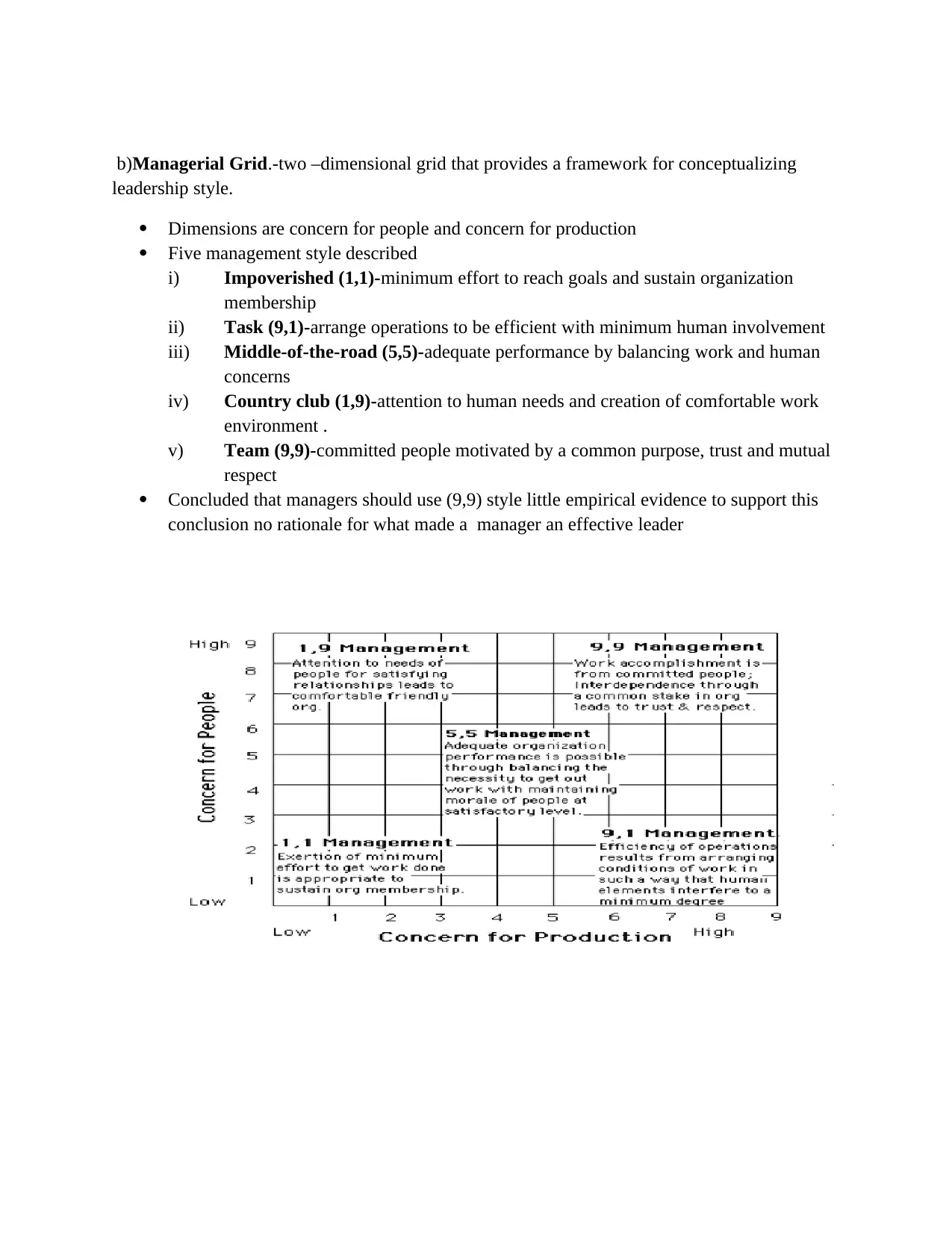
b)Managerial Grid.-two –dimensional grid that provides a framework for conceptualizing
leadership style.
Dimensions are concern for people and concern for production
Five management style described
i) Impoverished (1,1)-minimum effort to reach goals and sustain organization
membership
ii) Task (9,1)-arrange operations to be efficient with minimum human involvement
iii) Middle-of-the-road (5,5)-adequate performance by balancing work and human
concerns
iv) Country club (1,9)-attention to human needs and creation of comfortable work
environment .
v) Team (9,9)-committed people motivated by a common purpose, trust and mutual
respect
Concluded that managers should use (9,9) style little empirical evidence to support this
conclusion no rationale for what made a manager an effective leader
leadership style.
Dimensions are concern for people and concern for production
Five management style described
i) Impoverished (1,1)-minimum effort to reach goals and sustain organization
membership
ii) Task (9,1)-arrange operations to be efficient with minimum human involvement
iii) Middle-of-the-road (5,5)-adequate performance by balancing work and human
concerns
iv) Country club (1,9)-attention to human needs and creation of comfortable work
environment .
v) Team (9,9)-committed people motivated by a common purpose, trust and mutual
respect
Concluded that managers should use (9,9) style little empirical evidence to support this
conclusion no rationale for what made a manager an effective leader
⊘ This is a preview!⊘
Do you want full access?
Subscribe today to unlock all pages.

Trusted by 1+ million students worldwide
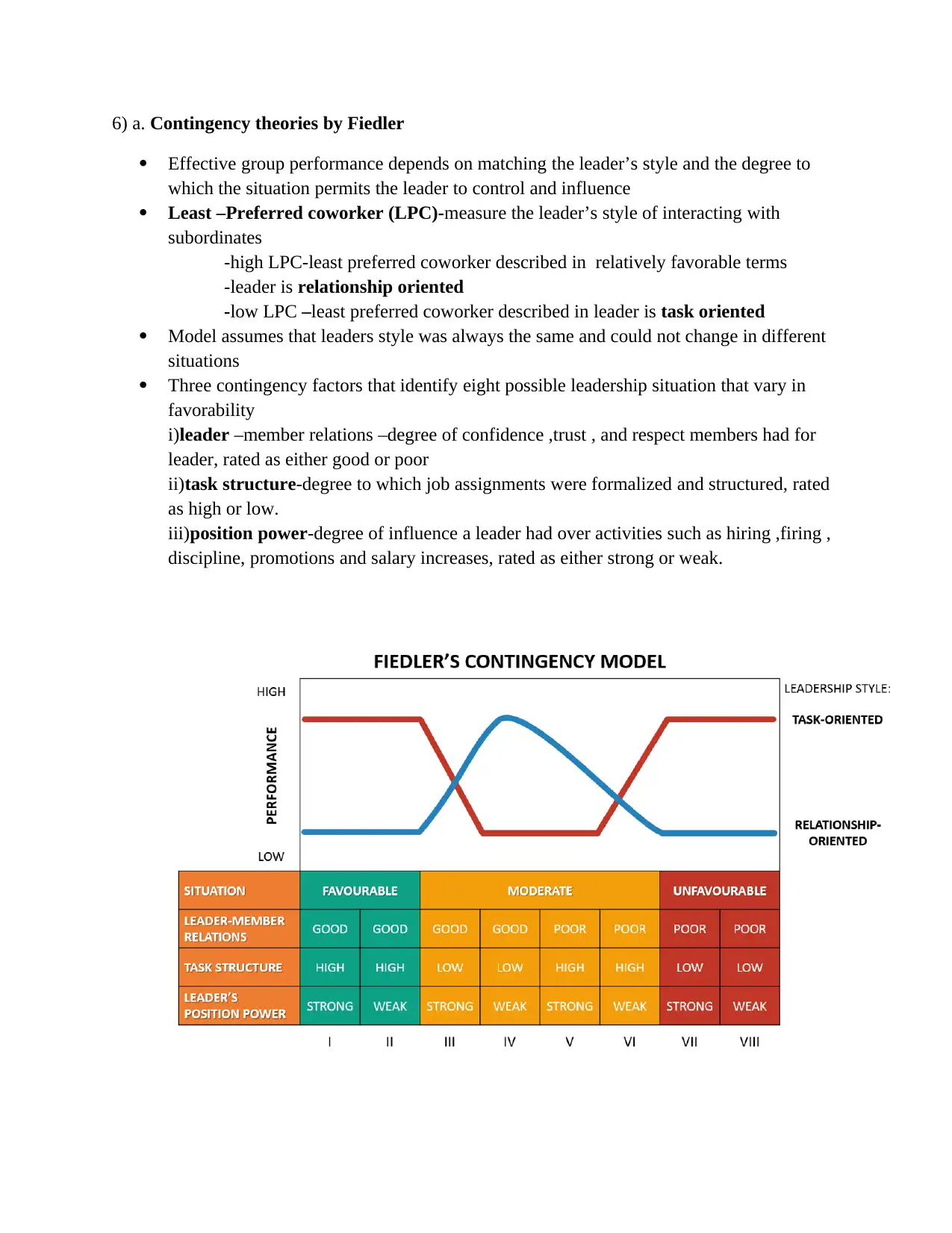
6) a. Contingency theories by Fiedler
Effective group performance depends on matching the leader’s style and the degree to
which the situation permits the leader to control and influence
Least –Preferred coworker (LPC)-measure the leader’s style of interacting with
subordinates
-high LPC-least preferred coworker described in relatively favorable terms
-leader is relationship oriented
-low LPC –least preferred coworker described in leader is task oriented
Model assumes that leaders style was always the same and could not change in different
situations
Three contingency factors that identify eight possible leadership situation that vary in
favorability
i)leader –member relations –degree of confidence ,trust , and respect members had for
leader, rated as either good or poor
ii)task structure-degree to which job assignments were formalized and structured, rated
as high or low.
iii)position power-degree of influence a leader had over activities such as hiring ,firing ,
discipline, promotions and salary increases, rated as either strong or weak.
Effective group performance depends on matching the leader’s style and the degree to
which the situation permits the leader to control and influence
Least –Preferred coworker (LPC)-measure the leader’s style of interacting with
subordinates
-high LPC-least preferred coworker described in relatively favorable terms
-leader is relationship oriented
-low LPC –least preferred coworker described in leader is task oriented
Model assumes that leaders style was always the same and could not change in different
situations
Three contingency factors that identify eight possible leadership situation that vary in
favorability
i)leader –member relations –degree of confidence ,trust , and respect members had for
leader, rated as either good or poor
ii)task structure-degree to which job assignments were formalized and structured, rated
as high or low.
iii)position power-degree of influence a leader had over activities such as hiring ,firing ,
discipline, promotions and salary increases, rated as either strong or weak.
Paraphrase This Document
Need a fresh take? Get an instant paraphrase of this document with our AI Paraphraser
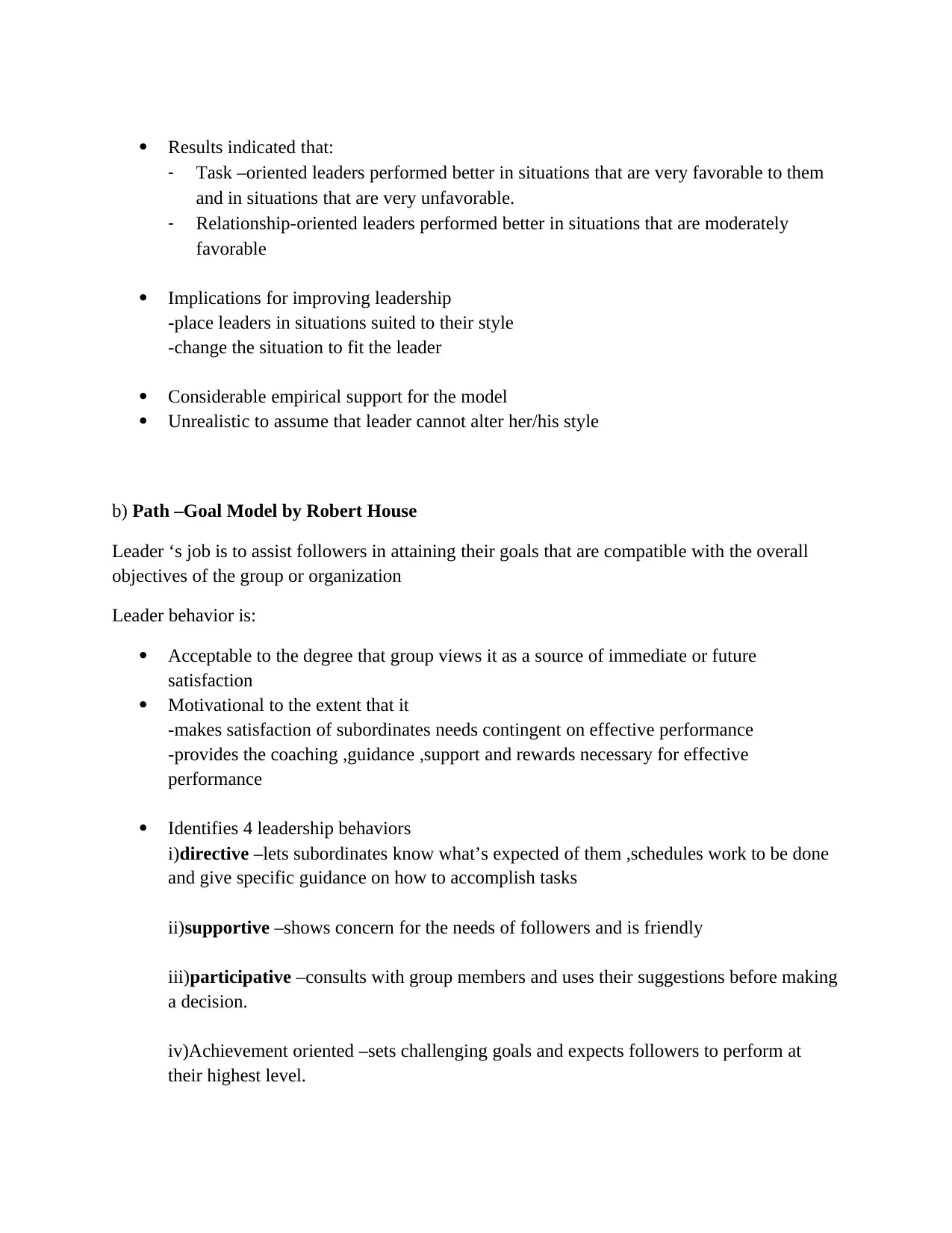
Results indicated that:
- Task –oriented leaders performed better in situations that are very favorable to them
and in situations that are very unfavorable.
- Relationship-oriented leaders performed better in situations that are moderately
favorable
Implications for improving leadership
-place leaders in situations suited to their style
-change the situation to fit the leader
Considerable empirical support for the model
Unrealistic to assume that leader cannot alter her/his style
b) Path –Goal Model by Robert House
Leader ‘s job is to assist followers in attaining their goals that are compatible with the overall
objectives of the group or organization
Leader behavior is:
Acceptable to the degree that group views it as a source of immediate or future
satisfaction
Motivational to the extent that it
-makes satisfaction of subordinates needs contingent on effective performance
-provides the coaching ,guidance ,support and rewards necessary for effective
performance
Identifies 4 leadership behaviors
i)directive –lets subordinates know what’s expected of them ,schedules work to be done
and give specific guidance on how to accomplish tasks
ii)supportive –shows concern for the needs of followers and is friendly
iii)participative –consults with group members and uses their suggestions before making
a decision.
iv)Achievement oriented –sets challenging goals and expects followers to perform at
their highest level.
- Task –oriented leaders performed better in situations that are very favorable to them
and in situations that are very unfavorable.
- Relationship-oriented leaders performed better in situations that are moderately
favorable
Implications for improving leadership
-place leaders in situations suited to their style
-change the situation to fit the leader
Considerable empirical support for the model
Unrealistic to assume that leader cannot alter her/his style
b) Path –Goal Model by Robert House
Leader ‘s job is to assist followers in attaining their goals that are compatible with the overall
objectives of the group or organization
Leader behavior is:
Acceptable to the degree that group views it as a source of immediate or future
satisfaction
Motivational to the extent that it
-makes satisfaction of subordinates needs contingent on effective performance
-provides the coaching ,guidance ,support and rewards necessary for effective
performance
Identifies 4 leadership behaviors
i)directive –lets subordinates know what’s expected of them ,schedules work to be done
and give specific guidance on how to accomplish tasks
ii)supportive –shows concern for the needs of followers and is friendly
iii)participative –consults with group members and uses their suggestions before making
a decision.
iv)Achievement oriented –sets challenging goals and expects followers to perform at
their highest level.
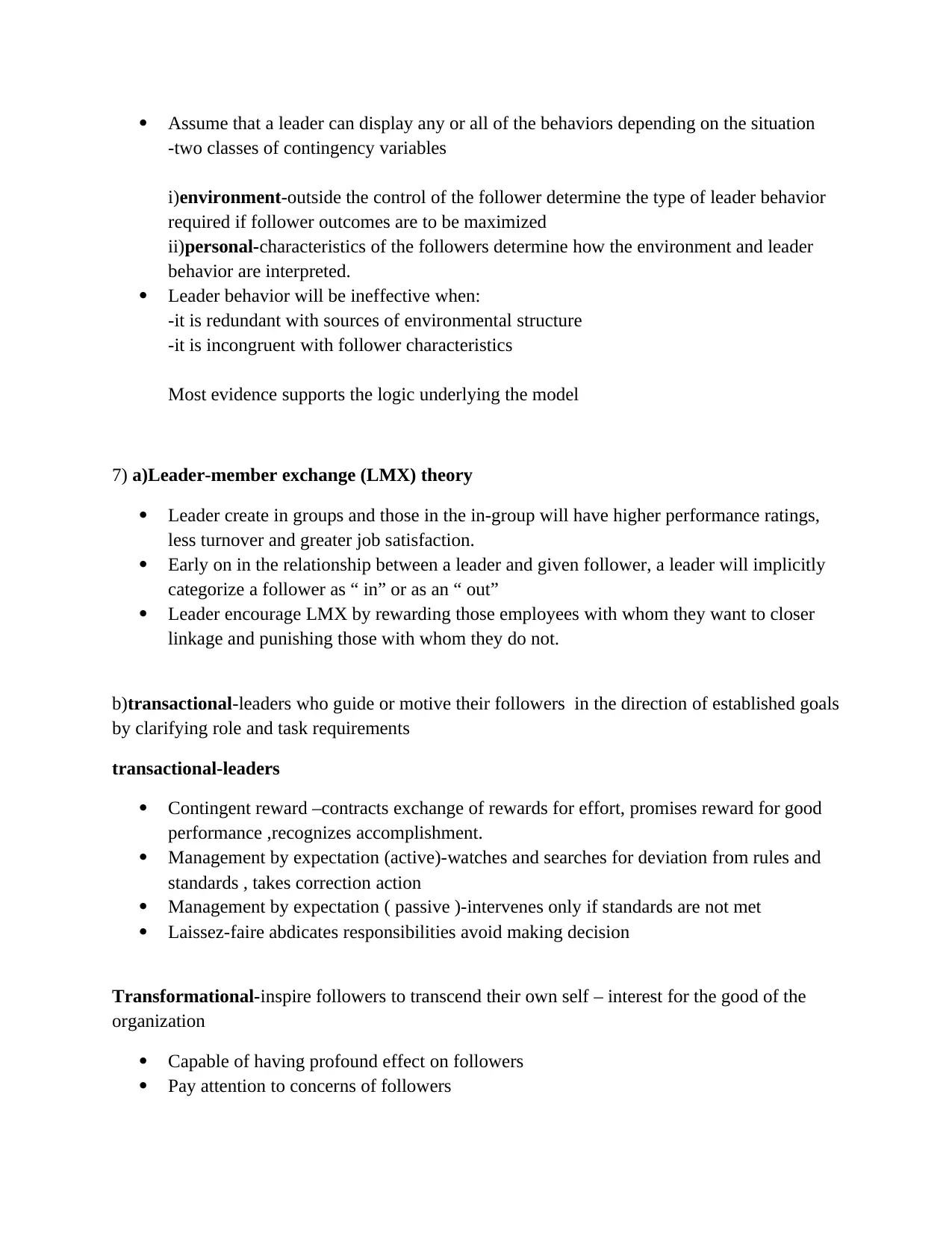
Assume that a leader can display any or all of the behaviors depending on the situation
-two classes of contingency variables
i)environment-outside the control of the follower determine the type of leader behavior
required if follower outcomes are to be maximized
ii)personal-characteristics of the followers determine how the environment and leader
behavior are interpreted.
Leader behavior will be ineffective when:
-it is redundant with sources of environmental structure
-it is incongruent with follower characteristics
Most evidence supports the logic underlying the model
7) a)Leader-member exchange (LMX) theory
Leader create in groups and those in the in-group will have higher performance ratings,
less turnover and greater job satisfaction.
Early on in the relationship between a leader and given follower, a leader will implicitly
categorize a follower as “ in” or as an “ out”
Leader encourage LMX by rewarding those employees with whom they want to closer
linkage and punishing those with whom they do not.
b)transactional-leaders who guide or motive their followers in the direction of established goals
by clarifying role and task requirements
transactional-leaders
Contingent reward –contracts exchange of rewards for effort, promises reward for good
performance ,recognizes accomplishment.
Management by expectation (active)-watches and searches for deviation from rules and
standards , takes correction action
Management by expectation ( passive )-intervenes only if standards are not met
Laissez-faire abdicates responsibilities avoid making decision
Transformational-inspire followers to transcend their own self – interest for the good of the
organization
Capable of having profound effect on followers
Pay attention to concerns of followers
-two classes of contingency variables
i)environment-outside the control of the follower determine the type of leader behavior
required if follower outcomes are to be maximized
ii)personal-characteristics of the followers determine how the environment and leader
behavior are interpreted.
Leader behavior will be ineffective when:
-it is redundant with sources of environmental structure
-it is incongruent with follower characteristics
Most evidence supports the logic underlying the model
7) a)Leader-member exchange (LMX) theory
Leader create in groups and those in the in-group will have higher performance ratings,
less turnover and greater job satisfaction.
Early on in the relationship between a leader and given follower, a leader will implicitly
categorize a follower as “ in” or as an “ out”
Leader encourage LMX by rewarding those employees with whom they want to closer
linkage and punishing those with whom they do not.
b)transactional-leaders who guide or motive their followers in the direction of established goals
by clarifying role and task requirements
transactional-leaders
Contingent reward –contracts exchange of rewards for effort, promises reward for good
performance ,recognizes accomplishment.
Management by expectation (active)-watches and searches for deviation from rules and
standards , takes correction action
Management by expectation ( passive )-intervenes only if standards are not met
Laissez-faire abdicates responsibilities avoid making decision
Transformational-inspire followers to transcend their own self – interest for the good of the
organization
Capable of having profound effect on followers
Pay attention to concerns of followers
⊘ This is a preview!⊘
Do you want full access?
Subscribe today to unlock all pages.

Trusted by 1+ million students worldwide
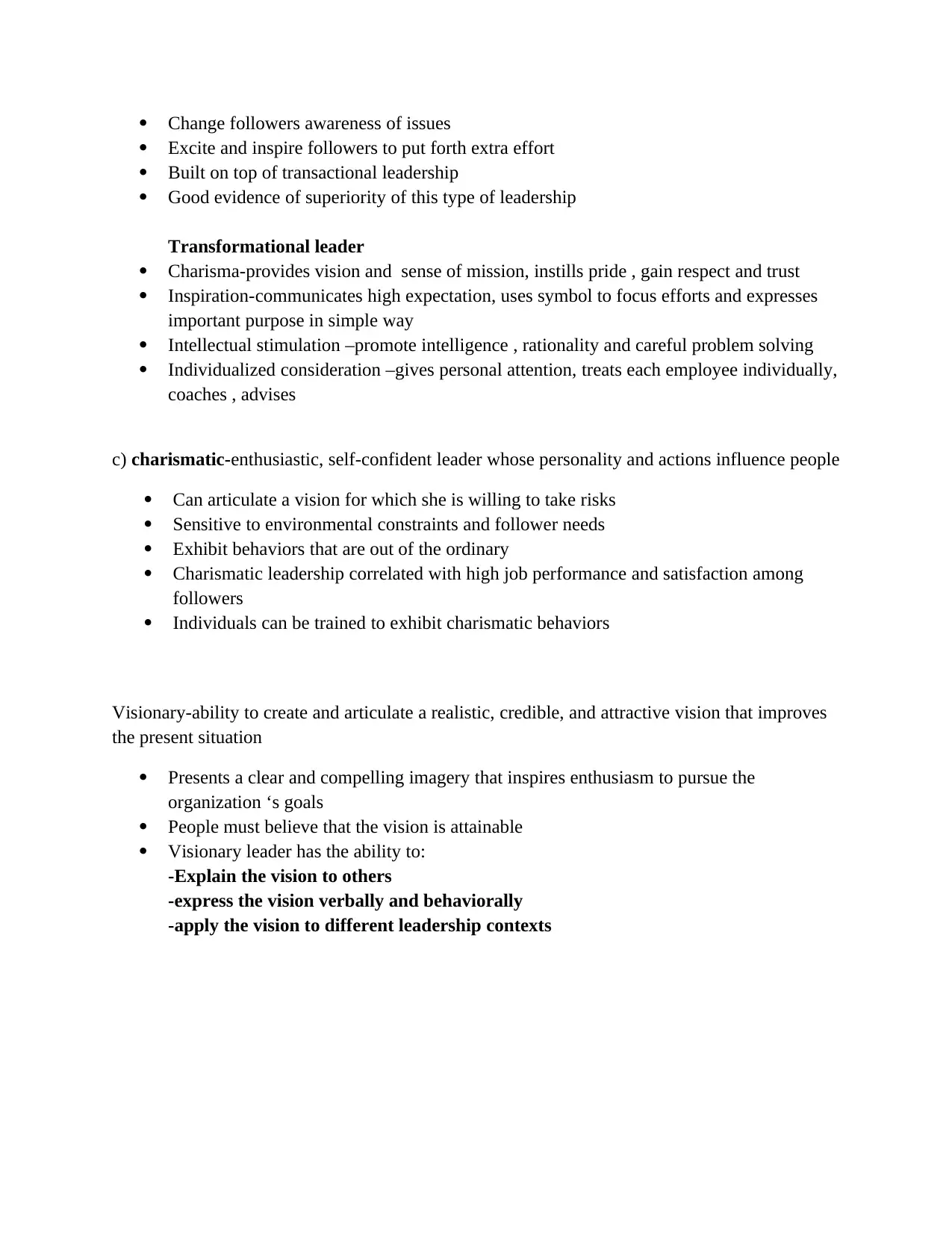
Change followers awareness of issues
Excite and inspire followers to put forth extra effort
Built on top of transactional leadership
Good evidence of superiority of this type of leadership
Transformational leader
Charisma-provides vision and sense of mission, instills pride , gain respect and trust
Inspiration-communicates high expectation, uses symbol to focus efforts and expresses
important purpose in simple way
Intellectual stimulation –promote intelligence , rationality and careful problem solving
Individualized consideration –gives personal attention, treats each employee individually,
coaches , advises
c) charismatic-enthusiastic, self-confident leader whose personality and actions influence people
Can articulate a vision for which she is willing to take risks
Sensitive to environmental constraints and follower needs
Exhibit behaviors that are out of the ordinary
Charismatic leadership correlated with high job performance and satisfaction among
followers
Individuals can be trained to exhibit charismatic behaviors
Visionary-ability to create and articulate a realistic, credible, and attractive vision that improves
the present situation
Presents a clear and compelling imagery that inspires enthusiasm to pursue the
organization ‘s goals
People must believe that the vision is attainable
Visionary leader has the ability to:
-Explain the vision to others
-express the vision verbally and behaviorally
-apply the vision to different leadership contexts
Excite and inspire followers to put forth extra effort
Built on top of transactional leadership
Good evidence of superiority of this type of leadership
Transformational leader
Charisma-provides vision and sense of mission, instills pride , gain respect and trust
Inspiration-communicates high expectation, uses symbol to focus efforts and expresses
important purpose in simple way
Intellectual stimulation –promote intelligence , rationality and careful problem solving
Individualized consideration –gives personal attention, treats each employee individually,
coaches , advises
c) charismatic-enthusiastic, self-confident leader whose personality and actions influence people
Can articulate a vision for which she is willing to take risks
Sensitive to environmental constraints and follower needs
Exhibit behaviors that are out of the ordinary
Charismatic leadership correlated with high job performance and satisfaction among
followers
Individuals can be trained to exhibit charismatic behaviors
Visionary-ability to create and articulate a realistic, credible, and attractive vision that improves
the present situation
Presents a clear and compelling imagery that inspires enthusiasm to pursue the
organization ‘s goals
People must believe that the vision is attainable
Visionary leader has the ability to:
-Explain the vision to others
-express the vision verbally and behaviorally
-apply the vision to different leadership contexts
Paraphrase This Document
Need a fresh take? Get an instant paraphrase of this document with our AI Paraphraser
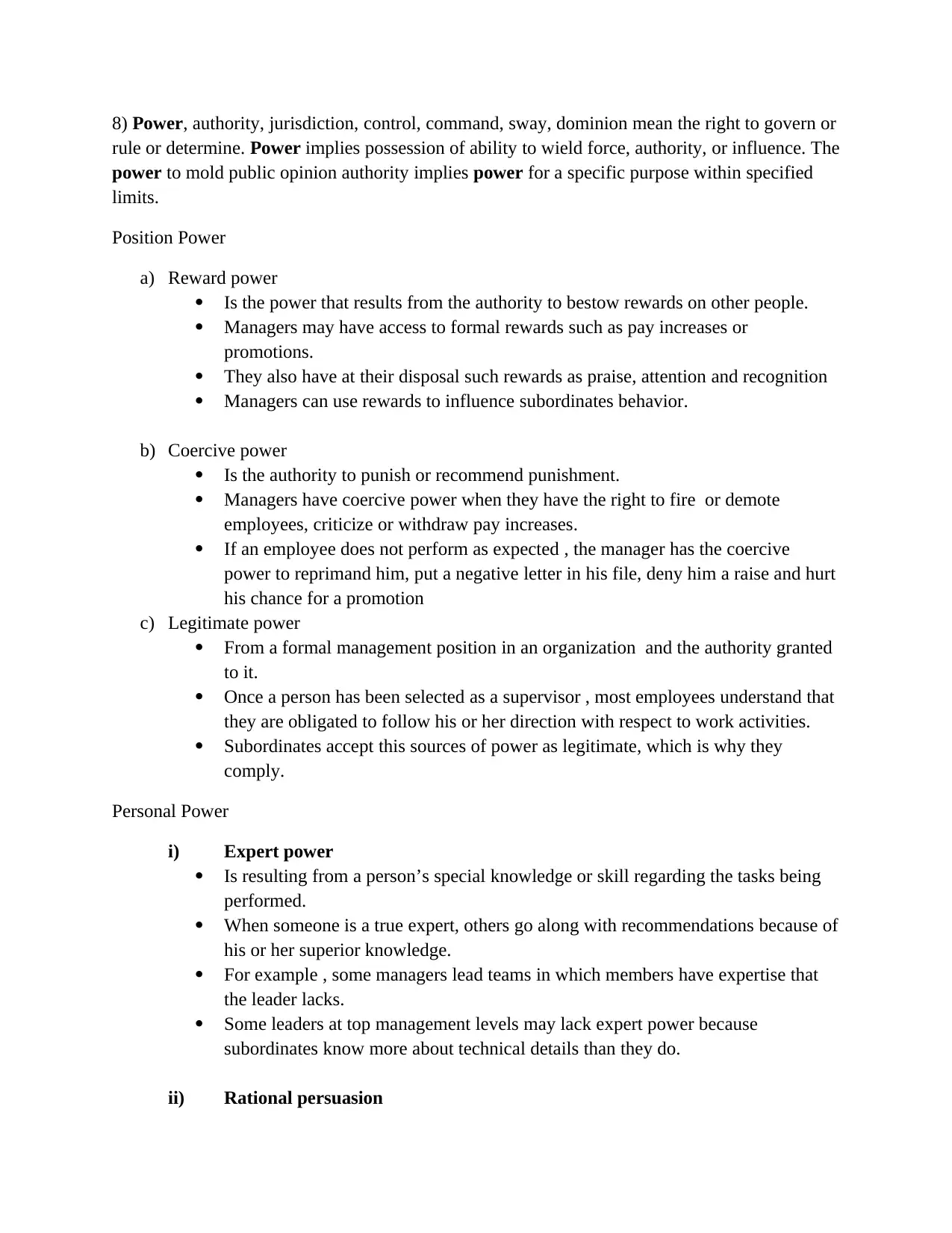
8) Power, authority, jurisdiction, control, command, sway, dominion mean the right to govern or
rule or determine. Power implies possession of ability to wield force, authority, or influence. The
power to mold public opinion authority implies power for a specific purpose within specified
limits.
Position Power
a) Reward power
Is the power that results from the authority to bestow rewards on other people.
Managers may have access to formal rewards such as pay increases or
promotions.
They also have at their disposal such rewards as praise, attention and recognition
Managers can use rewards to influence subordinates behavior.
b) Coercive power
Is the authority to punish or recommend punishment.
Managers have coercive power when they have the right to fire or demote
employees, criticize or withdraw pay increases.
If an employee does not perform as expected , the manager has the coercive
power to reprimand him, put a negative letter in his file, deny him a raise and hurt
his chance for a promotion
c) Legitimate power
From a formal management position in an organization and the authority granted
to it.
Once a person has been selected as a supervisor , most employees understand that
they are obligated to follow his or her direction with respect to work activities.
Subordinates accept this sources of power as legitimate, which is why they
comply.
Personal Power
i) Expert power
Is resulting from a person’s special knowledge or skill regarding the tasks being
performed.
When someone is a true expert, others go along with recommendations because of
his or her superior knowledge.
For example , some managers lead teams in which members have expertise that
the leader lacks.
Some leaders at top management levels may lack expert power because
subordinates know more about technical details than they do.
ii) Rational persuasion
rule or determine. Power implies possession of ability to wield force, authority, or influence. The
power to mold public opinion authority implies power for a specific purpose within specified
limits.
Position Power
a) Reward power
Is the power that results from the authority to bestow rewards on other people.
Managers may have access to formal rewards such as pay increases or
promotions.
They also have at their disposal such rewards as praise, attention and recognition
Managers can use rewards to influence subordinates behavior.
b) Coercive power
Is the authority to punish or recommend punishment.
Managers have coercive power when they have the right to fire or demote
employees, criticize or withdraw pay increases.
If an employee does not perform as expected , the manager has the coercive
power to reprimand him, put a negative letter in his file, deny him a raise and hurt
his chance for a promotion
c) Legitimate power
From a formal management position in an organization and the authority granted
to it.
Once a person has been selected as a supervisor , most employees understand that
they are obligated to follow his or her direction with respect to work activities.
Subordinates accept this sources of power as legitimate, which is why they
comply.
Personal Power
i) Expert power
Is resulting from a person’s special knowledge or skill regarding the tasks being
performed.
When someone is a true expert, others go along with recommendations because of
his or her superior knowledge.
For example , some managers lead teams in which members have expertise that
the leader lacks.
Some leaders at top management levels may lack expert power because
subordinates know more about technical details than they do.
ii) Rational persuasion
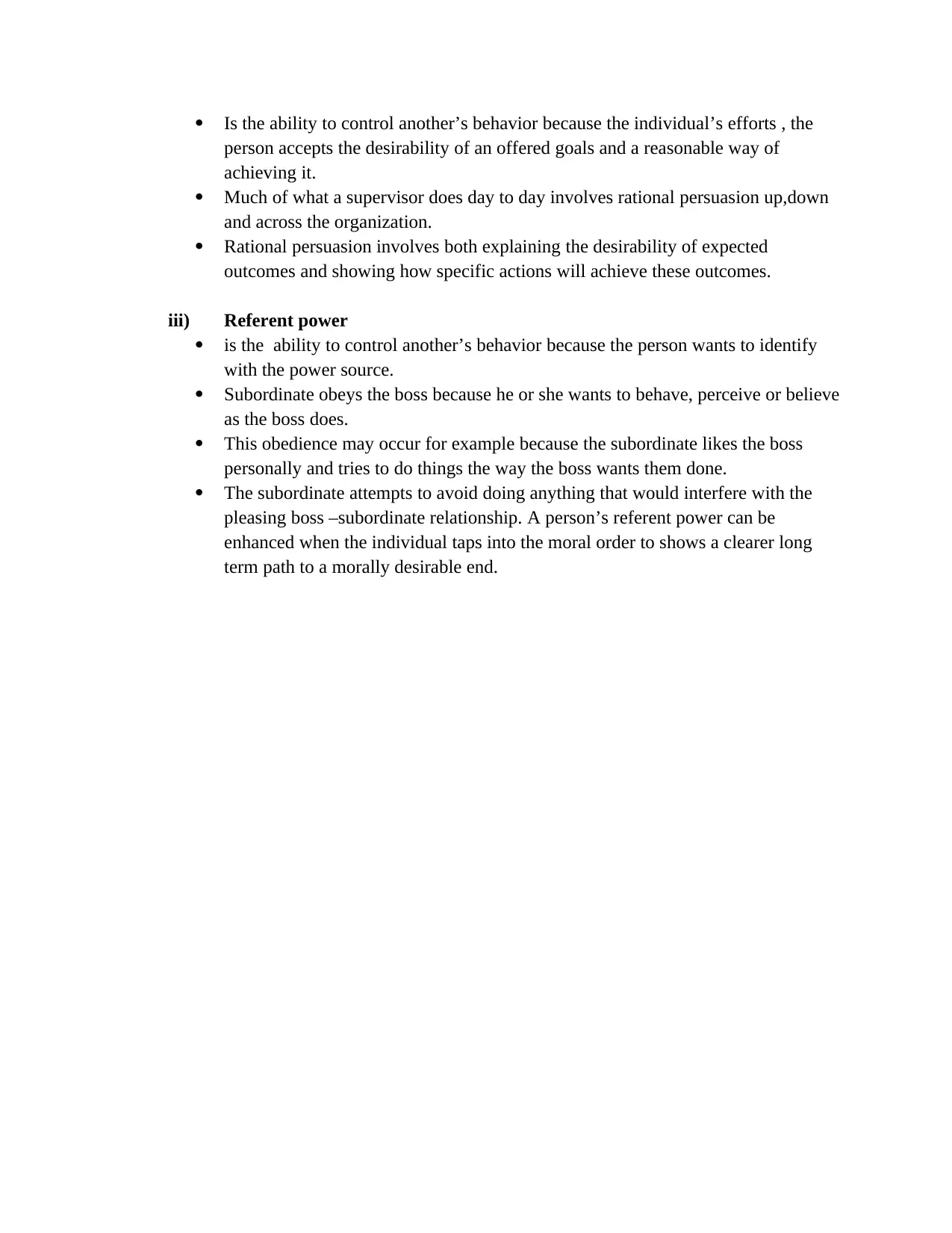
Is the ability to control another’s behavior because the individual’s efforts , the
person accepts the desirability of an offered goals and a reasonable way of
achieving it.
Much of what a supervisor does day to day involves rational persuasion up,down
and across the organization.
Rational persuasion involves both explaining the desirability of expected
outcomes and showing how specific actions will achieve these outcomes.
iii) Referent power
is the ability to control another’s behavior because the person wants to identify
with the power source.
Subordinate obeys the boss because he or she wants to behave, perceive or believe
as the boss does.
This obedience may occur for example because the subordinate likes the boss
personally and tries to do things the way the boss wants them done.
The subordinate attempts to avoid doing anything that would interfere with the
pleasing boss –subordinate relationship. A person’s referent power can be
enhanced when the individual taps into the moral order to shows a clearer long
term path to a morally desirable end.
person accepts the desirability of an offered goals and a reasonable way of
achieving it.
Much of what a supervisor does day to day involves rational persuasion up,down
and across the organization.
Rational persuasion involves both explaining the desirability of expected
outcomes and showing how specific actions will achieve these outcomes.
iii) Referent power
is the ability to control another’s behavior because the person wants to identify
with the power source.
Subordinate obeys the boss because he or she wants to behave, perceive or believe
as the boss does.
This obedience may occur for example because the subordinate likes the boss
personally and tries to do things the way the boss wants them done.
The subordinate attempts to avoid doing anything that would interfere with the
pleasing boss –subordinate relationship. A person’s referent power can be
enhanced when the individual taps into the moral order to shows a clearer long
term path to a morally desirable end.
⊘ This is a preview!⊘
Do you want full access?
Subscribe today to unlock all pages.

Trusted by 1+ million students worldwide
1 out of 9
Related Documents
Your All-in-One AI-Powered Toolkit for Academic Success.
+13062052269
info@desklib.com
Available 24*7 on WhatsApp / Email
![[object Object]](/_next/static/media/star-bottom.7253800d.svg)
Unlock your academic potential
Copyright © 2020–2025 A2Z Services. All Rights Reserved. Developed and managed by ZUCOL.





